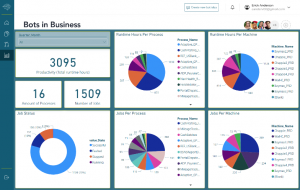Robotic Process Automation and ROI visualization
Robotic Process Automation (RPA) is revolutionizing the way businesses operate by automating repetitive tasks and boosting overall efficiency. As a result, organizations worldwide are increasingly investing in RPA solutions to remain competitive in the digital landscape. When it comes to justifying these investments, it is crucial to demonstrate the Return on Investment (ROI) for RPA in a clear and concise manner. In this article, we will explore the best ways to present ROI for Robotic Process Automation, enabling you to make data-driven decisions and maximize the benefits of your RPA projects.
Five key metrics
- Quantify the Time Savings:
One of the primary advantages of RPA is the significant time savings it offers by automating repetitive tasks. To present the ROI effectively, calculate the hours saved per week or per month and convert this into monetary value. By quantifying the time savings, you can demonstrate the cost reduction and improved productivity that RPA brings to your organization.

Nerve Center Visualization
- Measure the Improvement in Accuracy:
RPA reduces the likelihood of human error in manual processes, resulting in increased accuracy and better data quality. To showcase this benefit, track the error rates before and after RPA implementation. By highlighting the reduction in errors, you can illustrate the positive impact of RPA on your business operations and the subsequent improvement in your ROI.
- Calculate Cost Savings:
RPA can lead to significant cost savings by reducing labor costs and increasing operational efficiency. To present the ROI for RPA, compare the expenses associated with manual processes to the costs of implementing and maintaining RPA solutions. Be sure to include factors such as employee training, software licensing, and infrastructure costs in your calculations. By demonstrating the cost savings, you can show the financial benefits of investing in RPA technology.
- Highlight the Scalability:
RPA is highly scalable, allowing organizations to expand their automation capabilities as needed. When presenting the ROI for RPA, emphasize the potential for future growth and the ability to adapt to changing business needs. By showcasing the scalability of RPA, you can illustrate the long-term benefits and the potential for increased ROI over time.
- Showcase Employee Satisfaction:
Improved employee satisfaction is an often-overlooked benefit of RPA implementation. Automation of mundane tasks allows employees to focus on more valuable and engaging work, leading to higher job satisfaction and reduced turnover. To present this aspect of ROI, gather feedback from employees before and after RPA implementation and quantify the improvement in overall job satisfaction.
In conclusion
Presenting the ROI for Robotic Process Automation is essential for justifying investments and demonstrating the value of RPA to stakeholders. By quantifying time savings, measuring improvements in accuracy, calculating cost savings, highlighting scalability, and showcasing employee satisfaction, you can effectively communicate the benefits of RPA and maximize the return on your investments. Stay ahead of the competition and harness the power of RPA to optimize your business processes in 2023 and beyond.
The following article is an interesting perspective from UiPath: https://www.uipath.com/blog/rpa/rpa-and-the-roi-conundrum
Check out the Lanshore RPA – Nerve Center for ROI visualization: https://lanshore.com/rpa-nerve-center/
